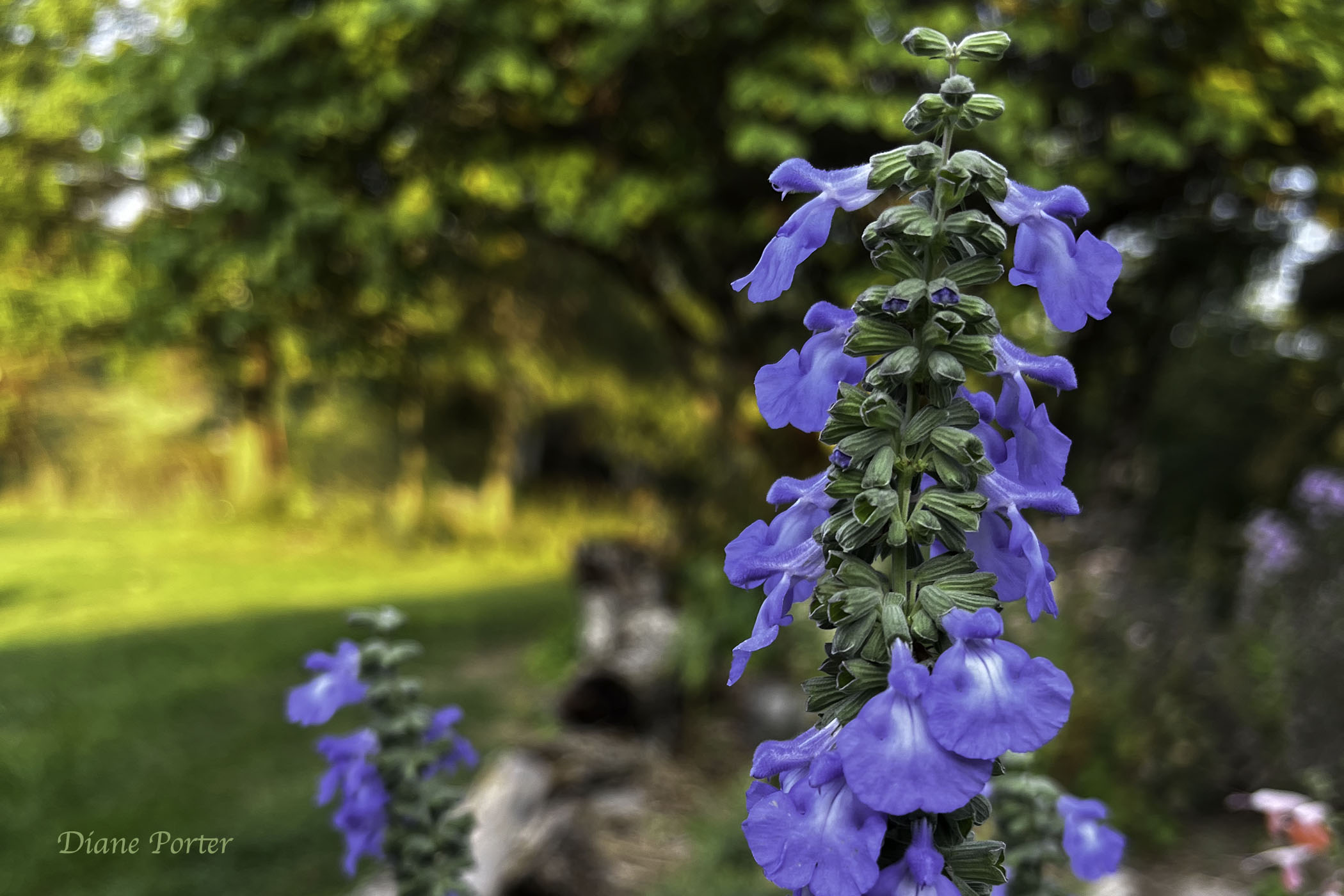Diane Porter of Fairfield first published this post in September on My Gaia, an email newsletter “about getting to know nature” and “giving her a helping hand in our own backyards.” Diane also maintains the Birdwatching Dot Com website and bird blog.
On the first full day of fall, the Blue sage (Salvia azurea) of my garden is in full bloom. Flower spikes are head high. Some are deep blue, others paler. The ones I love best are the color of an Iowa summer sky.

Down in the heart of each flower, the petals narrow and form a well. Inside, a drop of nectar pools. It is ready for a visitor, someone whose flight is powered by sugar, someone who will pollinate the blossom.
Usually it’s a bumblebee who comes. It lands on the ruffled platform of the lower petal and pushes its head into the flower, probing for sweetness with its tongue.
A bumblebee goes after the nectar. (This particular blue sage plant has flowers that are almost pure white.)

Blue sage devotes itself to bumblebees, who fit the flowers like key in lock. While the bee feeds on nectar, the flower executes a precision maneuver to deliver pollen smack onto the bee’s head.
Two pollen sacs hide inside the flower’s upper petal. The petal is curled almost into a tube, with a slit opening on the underside.
This image shows two pollen sacs, speckled with pollen, pivoting down from the curled petal.

HOW BLUE SAGE DELIVERS POLLEN
While the bee probes the flower, the two pollen sacs suddenly descend. The pollen sacs are concave, curved to fit the bumblebee’s head. They stamp the pollen onto the bee.
I’d read that the bee’s tongue presses against levers that swing the pollen sacs down. Now normally the pollen sacs are concealed inside the curled upper petal. Even when they swing into action, the bee’s head is in the way and prevents a view.
I wanted to see it work. I took a needle-thin piece of a grass stem and poked it gently into a blossom. My hands felt huge and clumsy, but I tried to do it delicately, as if the stem were the tongue of a bee.
Video through my microscope: a blue sage blossom is triggered to lower its pollen sacs.
To my astonishment, I watched the two pollen sacs pivot down. A bee would certainly have gotten its head stamped with pollen.
If you have Blue Sage in your garden, you can try this yourself. In the throat of the flower, you will see two pale bumps. Each bump is the other end of the lever that connects to a pollen sac. Press the bump with a thin instrument, like a grass stem or a pencil lead.
THE OTHER HALF OF POLLINATION
By the time the blossom has been visited a few times by bumblebees, it has given up its pollen. The anthers shrivel. That blossom is finished donating pollen.
Besides the pollen sacs, there is also a sort of pale fishhook that emerges from the upper petal. It is split in two parts. One curves up and the other points downward, toward where the bee’s head will be. This two-part structure is the stigma, the female part of the flower. After the pollen stage is over, the stigma matures. The tip of the lower branch becomes ready to receive pollen.
The next photo shows a two-part stigma, ready to receive pollen from a bee. Only the lower branch of the stigma is receptive. No one really knows what the function is of the upper branch.

A bee that already has pollen on its head bumps into the stigma when it visits the flower. Pollen transfers from bee head to stigma, and pollination is achieved.
OTHER VISITORS
Although blue sage is engineered for bumblebees, butterflies and occasionally even hummingbirds visit it as well. Everybody loves nectar.
Ruby-throated hummingbird visits blue sage flowers:

Orange Sulphur butterfly feeds on nectar:

Butterflies and birds are not efficient pollinators for this native wildflower. For them, blue sage is purely a gift. Gift to the butterfly, gift to the hummingbird, and of course a gift to the gardener.



1 Comment
What a wonderful way...
…to be introduced to a flower that is only indigenous to a few counties in Iowa. And what a beautiful flower for gardeners who want to help pollinators. Thank you, Diane.
PrairieFan Fri 24 Oct 11:38 PM